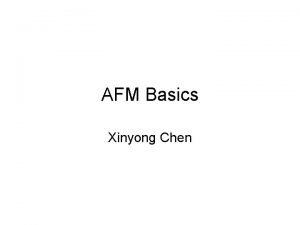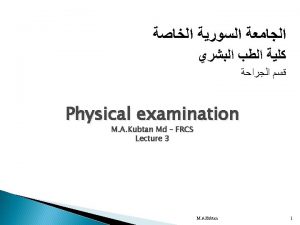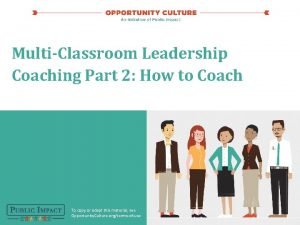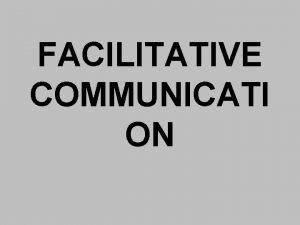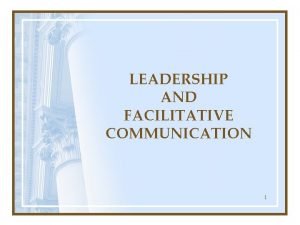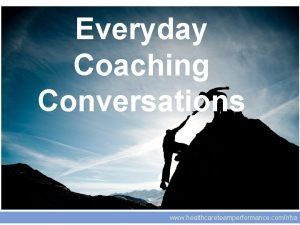Coaching Conversations Content adapted from Facilitative Leadership Tapping













- Slides: 13

Coaching Conversations Content adapted from Facilitative Leadership: Tapping the Power of Participation Interaction Associates, Inc

Coach for Performance Coaching is a conversation in which the coach instructs, counsels and tutors another in how to improve performance. Effective coaching yields more than improved performance; it also increases personal satisfaction, inspires a commitment to excellence, and fosters the coachee’s development as a leader.

UDL Leadership As leaders in UDL in your school, your role is coach all staff. Your goal is to improve performance school-wide through the implementation of UDL practices. You will not necessarily have a formalized coach/coachee relationship with a specific person. However, the research on effective coaching applies to your role as an instructional leader in your school as well.

Coaching Conversations As an instructional leader, you will have many conversations with colleagues: § § As a member of a team / department meeting As a participant in a staff meeting As a presenter in a staff or department meeting Informally with colleagues on breaks, during planning time, and in the hallways In all of these interactions, you can be purposeful in crafting your conversations as “coaching conversations. ”

Types of Coaching Conversations Type Feedback Problem-Solving Developmental Purpose To reinforce or change a specific pattern of behavior To figure out the best approach for solving a problem, pursuing an opportunity, or producing a specific result To define the coachee’s professional or personal aspirations and explore alternative pathways for realizing those aspirations

Reflect Which types of coaching conversations might you have as a participant in a meeting? … as a presenter at a meeting? … informally with one or two colleagues? How might you better use your opportunities to interact with colleagues to further the implementation of UDL in your school?

Attributes of Effective Coaching Conversations Collaborative The intention to act in a cooperative and supportive manner. Strategic The mental process of selecting an appropriate pathway or approach for the conversation in order to achieve desired results. Receptive & Flexible The demonstration of openness to alternative ideas; and willingness to adjust plans based on new information. Shared Responsibility Playing an active role in the conversation and holding oneself and each other accountable for success.

Coach’s Tools Inquiry § A process for understanding the coachee’s point of view by exploring his/her thoughts, feelings, and reasoning. Techniques for Inquiry Advocacy § A process for influencing the coachee’s thinking and behavior by stating one’s opinions and suggestions, and outlining the rationale for each. Advocacy Guidelines for Coaches

• To confirm something you suspect the coachee may be thinking or feeling. This deepens your ability to understand empathize with the coachee. Name your assumptions and ask if your perceptions are correct. Ask Probing Questions • To validate the coachee and confirm what you think you heard him/her say. Restate the coachee’s position in your own words. Check Perceptions • To create an open mind so that you can listen, free from your own filters, to the other’s point of view. Turn down the volume of your own internal chatter and listen openly. Paraphrase Bracket Inquiry Techniques • To get more information and deepen understanding. Ask basic questions. Make sure the intention of your questions is to seek more information, not to veil an evaluation or challenge.

Reflect Do you perceive yourself as someone that others at school might come to for support or advice? How often do you use these inquiry techniques already to support your colleagues?

Advocacy and Presentations When you are asked to share your knowledge by presenting to a group, you are in a position of advocacy. You are presenting some information that you want others to respond to in a certain way. So, as a presenter, you are an advocate for a particular practice and point of view.

Advocacy Guidelines for Presenters Acknowledge the situation § “I know that it is hard to differentiate for the needs of diverse learners in our classrooms. ” State your advocacy § “I have found UDL practices very helpful to me in finding ways to frontload strategies for all students and save time in the long run. ” Outline the reasoning behind your advocacy § “I want to share with you an example of how Jenny’s writing improved when I started giving her more choices in the classroom. ” Check for understanding and encourage inquiry § “Given my description, what are some examples of choices that you give students in your classrooms already? ” § “Let’s share some challenges for doing this more regularly. ”

Reflect Presentations don’t have to be formal. When you are sharing your point of view at a team meeting, and when you are speaking as a participant of a group meeting, you are, in effect, presenting your ideas. Think of how these advocacy guidelines could help you be more effective as a leader in a variety of situations at school.
 Tapping sounds
Tapping sounds Tapping global markets
Tapping global markets Tapping into global markets
Tapping into global markets Which of the following machine is portable mcq
Which of the following machine is portable mcq Paricardium
Paricardium Dave lawton
Dave lawton Tapping mode afm animation
Tapping mode afm animation Empower tapping
Empower tapping Tympany sound percussion
Tympany sound percussion Tapping tube smelter
Tapping tube smelter What is esp
What is esp Static content vs dynamic content
Static content vs dynamic content Breakthrough coaching and leadership academy
Breakthrough coaching and leadership academy Leverage leadership coaching model
Leverage leadership coaching model






